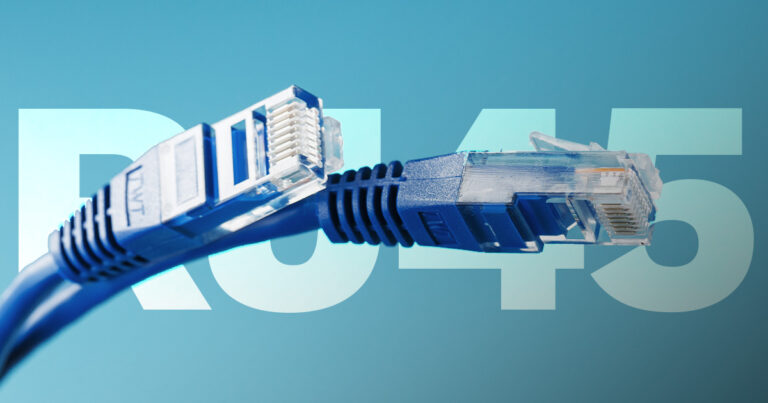Ethernet predates wireless, offering lower latency and faster speeds for local transfers and internet connectivity.
RJ45 Ethernet LAN cable buying guide
The world has been wooed by WiFi. And why fight it. WiFi 6 has boosted the perks of wireless connectivity, unlocking faster speeds and lower latencies. But no matter how fast WiFi gets in the future, it’ll always be beaten by the not-so-humble Ethernet cable.
Here’s all of the essential info you need to know about buying an RJ45 Ethernet LAN cable today.

What is an RJ45 Ethernet LAN cable?
In basic terms, an RJ45 Ethernet LAN cable is what you use for a wired network connection between router or modem-router and a compatible device. But while the “cable” part of the name makes sense, the other bits are drenched in jargon. Let’s tease them out.
RJ45 is short for ‘Registered Jack-45’. In practical terms, RJ45 refers to the plastic plug on the end of an Ethernet cable which is, mercifully, backwards and forwards compatible, meaning you can happily use Ethernet cables across devices.
Known as Institute of Electrical and Electronics Engineers (IEEE) 802.3 when it’s in trouble, Ethernet is the more accessible nickname among friends. Ethernet refers to wired connectivity for local area network (LAN) connections. And LAN is shorthand for the network within your home; contrast it with wide area network (WAN), which is the network outside your home (aka, the internet).
How many types of Ethernet cable are there?
We’ve covered crossover and patch cables above, but that’s just scratching the surface of the technology beneath the protective outer shell. One of the main benefits of an Ethernet port is that it’s both backwards and (technically) forwards compatible. This means you can use an ancient or cutting-edge Ethernet cable and it should still work with all your devices.
The catch is that while RJ45 Ethernet LAN cables mostly look alike, there are different Ethernet category types (Cat types) that determine speed. Similarly, the Ethernet port needs to be rated for a particular Cat type speed to enjoy the fastest possible available speeds, which will otherwise be limited to the slowest speed, be that internet, Ethernet cable or Ethernet port.
It’s kind of like tapping into a 5G mobile network. To take advantage of 5G speeds, you need a 5G smartphone, a 5G mobile plan and you need to be in an area with 5G network coverage. If any one of those three factors aren’t met, you’ll be limited to 4G (or even 3G) mobile connectivity.
Here’s a look at the different Ethernet Cat types. Use this as a guide to identify existing Ethernet cables—spin them around and search for writing on the cable—or to purchase new ones.
RJ45 Ethernet LAN cable buying guide
The most important parts of that table are the Cat type and the max speeds. If you’re using a Cat5 Ethernet cable, you’ll be restricted to 100Mbps speeds. That’s okay for an NBN 100 connection in terms of download speeds, but it doesn’t account for the upload speed, and it will result in slow LAN file transfers. Similarly, a Cat5e cable goes up to 1Gbps, which is great for an NBN 1000 plan in terms of download, but it doesn’t factor in the 50Mbps upload speed potential.
Note that if you use a Cat5 or Cat5e cable to connect NBN modem to router, your internet speed will be capped at 100Mbps and 1Gbps, respectively. If a Cat5 or Cat5e cable is used to connect an individual device to a router, modem-router or network switch, the speed to and from that device will be capped at 100Mbps or 1Gbps.
Ideally, you want to use a Cat6 Ethernet cable (or faster) for set-and-forget future-proofing. Admittedly, gigabit (aka 1Gbps) is still the standard even for computers, game consoles like the Xbox Series X and PlayStation , routers, network switches and network-attached storage (NAS) devices. Connecting a Cat6 Ethernet cable to any device that has gigabit Ethernet will only allow for maximum gigabit speeds, which is 125MBps (that’s megabytes, not megabits) for those who love to transfer big files over LAN.
To take full advantage of the latest Ethernet Cat types, you’d need a 10Gbps (or faster) router, Cat6 Ethernet cables (or better) and a device with a 10Gbps (or faster) Ethernet port. Honestly, that’s not entirely practical, plus the latest Ethernet Cat types cost more. Additionally, the longer the Ethernet cable, the greater the cost. Basically, you can save some bucks by opting for Cat6 Ethernet cables.
Ethernet vs WiFi: Which is better?
In terms of the basics, Ethernet is faster and more reliable than WiFi, with lower latency. Ethernet doesn’t suffer from wireless interference like WiFi does, and even with an NBN 100 plan or below, Ethernet is great for faster LAN file transfers. This can be a big help with NAS backups or multiple Xbox Series X|S consoles in the same home, which allow for game transfers across LAN.
There’s no denying the convenience of WiFi, though. A wired connection creates a potential trip hazard, which is only addressable by hiding cables under mats, carpet, running longer Ethernet cables over doorways and away from feet, or paying a professional to install the cables inside the walls. WiFi has speedy short-range 5GHz for newer devices that are close to the router or modem-router, plus slower longer-range 2.4GHz for devices farther away. If there is interference or wireless dead spots in your home, consider a WiFi extender or WiFi mesh system.
RJ45 Ethernet LAN cable FAQs
Related Articles




